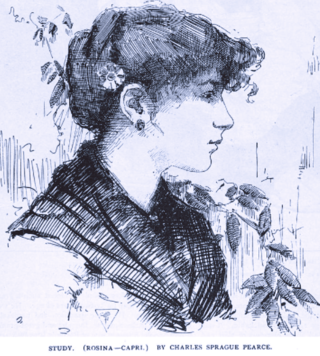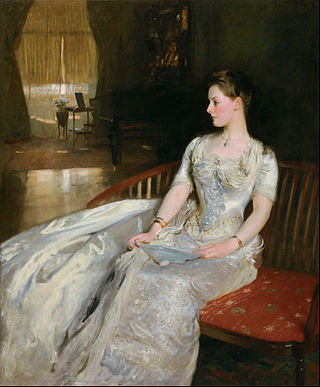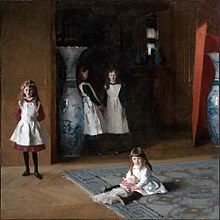
Thomas Gainsborough was an English portrait and landscape painter, draughtsman, and printmaker. Along with his rival Sir Joshua Reynolds, he is considered one of the most important British artists of the second half of the 18th century. He painted quickly, and the works of his maturity are characterised by a light palette and easy strokes. Despite being a prolific portrait painter, Gainsborough gained greater satisfaction from his landscapes. He is credited as the originator of the 18th-century British landscape school. Gainsborough was a founding member of the Royal Academy.

John Singer Sargent was an American expatriate artist, considered the "leading portrait painter of his generation" for his evocations of Edwardian-era luxury. He created roughly 900 oil paintings and more than 2,000 watercolors, as well as countless sketches and charcoal drawings. His oeuvre documents worldwide travel, from Venice to the Tyrol, Corfu, Spain, the Middle East, Montana, Maine, and Florida.

Madame X or Portrait of Madame X is a portrait painting by John Singer Sargent of a young socialite, Virginie Amélie Avegno Gautreau, wife of the French banker Pierre Gautreau. Madame X was painted not as a commission, but at the request of Sargent. It is a study in opposition. Sargent shows a woman posing in a black satin dress with jeweled straps, a dress that reveals and hides at the same time. The portrait is characterized by the pale flesh tone of the subject contrasted against a dark-colored dress and background.

Paul César Helleu was a French oil painter, pastel artist, drypoint etcher, and designer, best known for his numerous portraits of beautiful society women of the Belle Époque. He also conceived the ceiling mural of night sky constellations for Grand Central Terminal in New York City. He was also the father of Jean Helleu and the grandfather of Jacques Helleu, both artistic directors for Parfums Chanel.

Virginie Amélie Avegno Gautreau was an American-born Parisian socialite, who gained notoriety as the subject of John Singer Sargent's painting Portrait of Madame X. The suggestion of indiscreet posing in a revealing costume provoked a storm of outrage.

The Daughters of Edward Darley Boit is a painting by the American artist John Singer Sargent. The painting depicts four young girls, the daughters of Edward Darley Boit, in their family's Paris apartment. It was painted in 1882 and is now exhibited in the new Art of the Americas Wing of the Museum of Fine Arts in Boston. The painting hangs between the two tall blue-and-white Japanese vases depicted in the work, which were donated by the heirs of the Boit family.

Rosina Ferrara (1861–1934) was an Italian artist's model from the island of Capri, who became the favorite muse of American expatriate artist John Singer Sargent. Captivated by her exotic beauty, a variety of 19th-century artists, including Charles Sprague Pearce, Frank Hyde, and George Randolph Barse, made works of art of her. Ferrara was featured in the 2003 art exhibit "Sargent's Women" at New York City's Adelson Galleries, as well as in the book Sargent's Women published that year.

Joseph William Comyns Carr, often referred to as J. Comyns Carr, was an English drama and art critic, gallery director, author, poet, playwright and theatre manager.

Street in Venice is a c. 1882 oil on wood painting by the American artist John Singer Sargent (1856–1925). Painted in an impressionist manner, it is set in a quiet backstreet off the Calle Larga dei Proverbi, near the Grand Canal in Venice. The painting shows a young woman walking along the flagstones, kicking her skirt with her right foot, and observed by two men in the shadows to her right. From the manner in which Sargent depicts her down-turned eyes and seemingly fast pace with which she passes the two men, he is concerned largely with the invasive male glare and its effect on the passing woman.

El Jaleo is a large painting by John Singer Sargent, depicting a Spanish Romani dancer performing to the accompaniment of musicians. Painted in 1882, it currently hangs in the Isabella Stewart Gardner Museum, in Boston.

Colonel Thomas Edward Vickers was Chairman of Vickers Limited.

Woman with a Parasol – Madame Monet and Her Son, sometimes known as The Stroll is an oil-on-canvas painting by Claude Monet from 1875. The Impressionist work depicts his wife Camille Monet and their son Jean Monet in the period from 1871 to 1877 while they were living in Argenteuil, capturing a moment on a stroll on a windy summer's day.

Fanny Eaton was a Jamaican-born artist's model and domestic worker. She is best known as a model for the Pre-Raphaelite Brotherhood and their circle in England between 1859 and 1867. Her public debut was in Simeon Solomon's painting The Mother of Moses, which was exhibited at the Royal Academy in 1860. She was also featured in works by Dante Gabriel Rossetti, John Everett Millais, Joanna Mary Boyce, Rebecca Solomon, and others.

The Wyndham Sisters: Lady Elcho, Mrs. Adeane, and Mrs. Tennant is an 1899 painting by John Singer Sargent. It is part of the collection of the Metropolitan Museum of Art. The painting was hailed by the critics and dubbed “The Three Graces” by the Prince of Wales.

Mrs. Hugh Hammersley is an 1892 painting by John Singer Sargent. It is part of the collection of the Metropolitan Museum of Art.

Mariette Leslie Cotton (1866–1947) was an American artist who usually gave her name as Mrs. Leslie Cotton. A student of William Merritt Chase, Carolus-Duran, and Jean-Jacques Henner, she worked mainly in Paris but also maintained studios in London and New York. By birth and marriage she possessed a level of wealth and social prestige that, together with her artistic skill, enabled her to obtain lucrative commissions from prominent individuals. The portraits she painted were praised for their veracity, style, and fine technique. Their subjects included kings, aristocrats, celebrities, and members of wealthy families. Late in her career a critic wrote that her "popularity has a sound basis, for her portraits combine such abstract artistic qualities as effective and infinitely varied design and daringly unconventional arrangements of color, with strong characterization and a likeness that never fails to be convincing," and added, "her concern with the artistic problem never makes her obtrude her own personality or offend the sitter's susceptibilities."

Portrait of Mrs. Cecil Wade or Portrait of a Lady is a large oil-on-canvas painting by John Singer Sargent, depicting Frances Frew Wade, a Scottish socialite. Painted in 1886, it currently hangs in the Nelson-Atkins Museum of Art in Kansas City, Missouri.

The Wertheimer portraits are a series of twelve portrait paintings made by John Singer Sargent (1856–1925) of and for the British art dealer Asher Wertheimer (1843–1918) and his family. The series amounts to Sargent's largest private commission.

Dr Pozzi at Home is an 1881 oil painting by the American artist John Singer Sargent. The portrait of the French gynaecologist and art collector Samuel Jean de Pozzi was Sargent's first large portrait of a male subject: it measures 201.6 cm × 102.2 cm. It was the first work that Sargent exhibited at the Royal Academy in London. It was acquired by Armand Hammer in 1967, and has been held by the Hammer Museum in Los Angeles since 1991.

Madame Georges Charpentier and Her Children is an 1878 oil on canvas painting by Pierre-Auguste Renoir. It depicts Marguerite Charpentier, a French salonist, art collector, and advocate of the Impressionists, and her children Georgette and Paul. The painting is held by the Metropolitan Museum of Art.





















